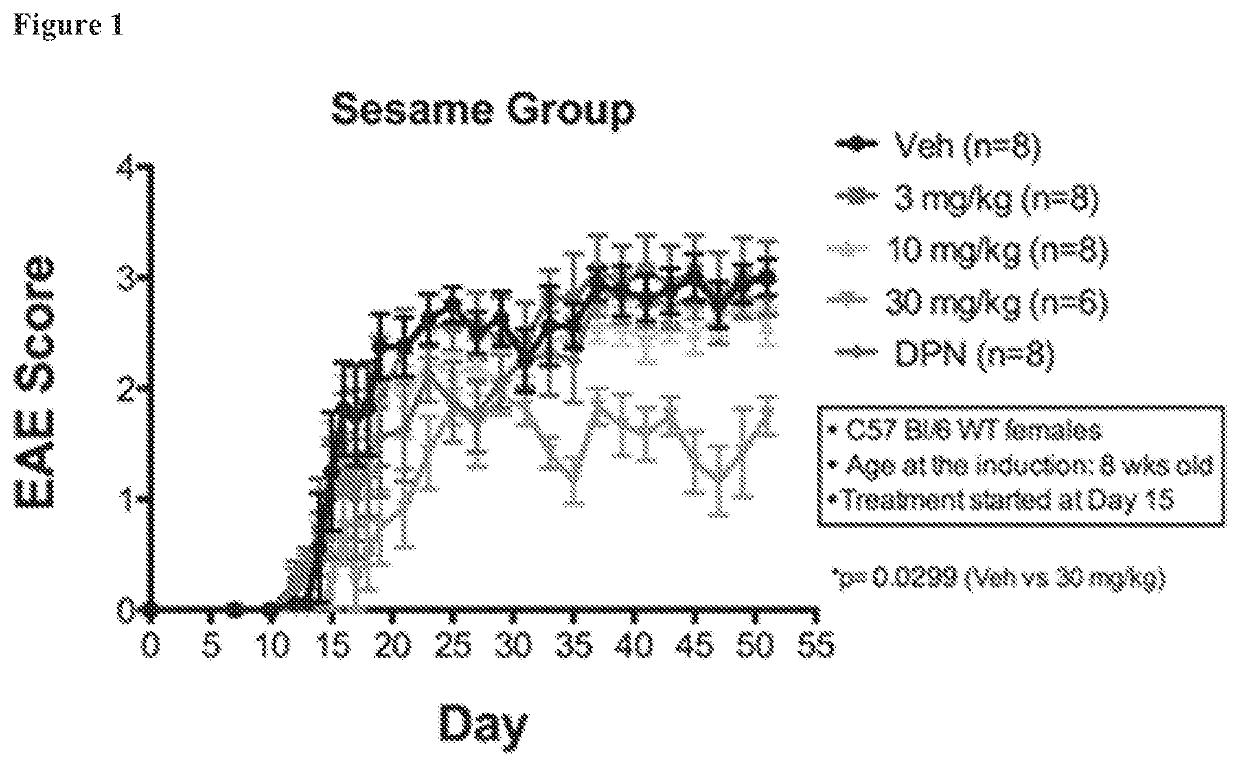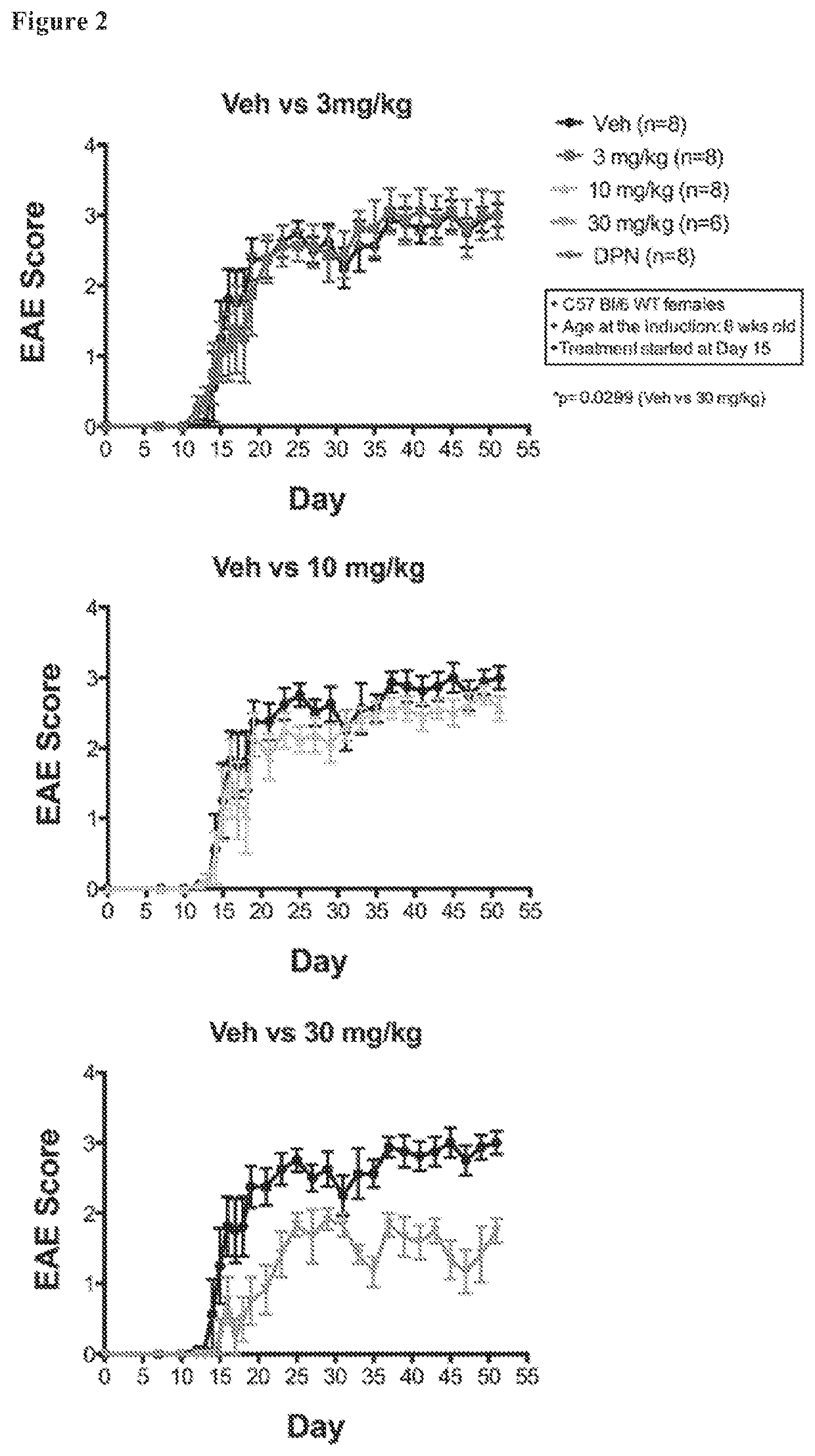Estrogen receptor ligand treatment for neurodegenerative diseases
a neurodegenerative disease and estrogen receptor technology, applied in the field of estrogen receptor ligand treatment for neurodegenerative diseases, can solve the problems that the treatment of estrogens or er alpha ligands may not be tolerable, and there are currently no purely neuroprotective treatments for ms, so as to improve the clinical symptoms of neurodegenerative diseases.
- Summary
- Abstract
- Description
- Claims
- Application Information
AI Technical Summary
Benefits of technology
Problems solved by technology
Method used
Image
Examples
example 1
Materials and Methods.
[0166]Animals.
[0167]C57BL / 6 and NOD mice 8 weeks old were purchased from Jackson Laboratories (Bar Harbor, Me.). Animals were maintained under environmentally controlled conditions in a 12-hour light / dark cycle with access to food and water ad libitum. All procedures were done in accordance with the guidelines of the National Institutes of Health and the Chancellor's Animal Research Committee of the University of California, Los Angeles Office for the Protection of Research Subjects.
[0168]Reagents.
[0169]AC-186 was dissolved in either Miglyol 812N liquid oil (Sasol North America) or sesame oil (Sigma Aldrich) as following concentration; 1.5 mg / mL for 3 mg / kg group, 5 mg / mL for 10 mg / kg group, and 15 mg / mL for 30 mg / kg group. Diarylpropionitrile (DPN, Tocris Biosciences) was dissolved in 10% molecular-grade ethanol and diluted with 90% of either Miglyol 812N liquid oil or sesame oil.
[0170]EAE and Treatments.
[0171]Animals were injected subcutaneously with Myelin O...
example 2
[0188]Three doses of the AC-186 compound were tested in C57BL / 6 female mice: low (3 mg / kg, every other day), medium (10 mg / kg, every other day), and high (30 mg / kg, every other day), each injected subcutaneously in a sesame oil vehicle. The ERβ ligand diarylpropionitrile (DPN) was tested as a positive control because DPN can partially ameliorate EAE and because the treatment effects in EAE experiments can vary based on the level of disease severity within an experiment. Direct comparisons between treatments were only made between treatment groups within a single EAE experiment and not between treatment groups of different EAE experiments. DPN, however, was difficult to dissolve in sesame oil, and thus, DPN was first dissolved in ethanol and added to sesame oil at a concentration of 10% ethanol in sesame oil. The AC-186 compound dissolved in sesame oil after five minutes on a nutating shaker. Thus, FIG. 1 shows graphs in which the vehicle consisted of sesame oil for AC-186 (all doses...
example 3
[0190]DPN protects against EAE better when administered in a Miglyol vehicle rather than in a sesame oil vehicle, and thus, the effect of the choice of vehicle on the efficacy of AC-186 was assessed. Accordingly, the AC-186 compound was assessed in C57BL / 6 males using sesame oil and miglyol as vehicles. Male mice receiving AC-186 administered at 30 mg / kg in miglyol performed significantly better than mice receiving miglyol alone as assessed by both EAE score (FIG. 5) and rotarod performance (FIG. 6). In contrast, male mice receiving AC-186 administered at 30 mg / kg in sesame oil did not perform significantly better than mice receiving sesame oil alone as assessed by EAE score (FIG. 5) and rotarod performance (FIG. 6). Notably, the AC-186 solution dissolved more rapidly in miglyol than sesame oil, and miglyol could dissolve AC-186 by merely pipetting for 30 seconds. In contrast, AC-186 required mixing / nutating for 5 minutes to dissolve the compound in sesame oil.
[0191]The 30 mg / kg dos...
PUM
| Property | Measurement | Unit |
|---|---|---|
| concentration | aaaaa | aaaaa |
| concentration | aaaaa | aaaaa |
| concentration | aaaaa | aaaaa |
Abstract
Description
Claims
Application Information
 Login to View More
Login to View More - R&D
- Intellectual Property
- Life Sciences
- Materials
- Tech Scout
- Unparalleled Data Quality
- Higher Quality Content
- 60% Fewer Hallucinations
Browse by: Latest US Patents, China's latest patents, Technical Efficacy Thesaurus, Application Domain, Technology Topic, Popular Technical Reports.
© 2025 PatSnap. All rights reserved.Legal|Privacy policy|Modern Slavery Act Transparency Statement|Sitemap|About US| Contact US: help@patsnap.com



